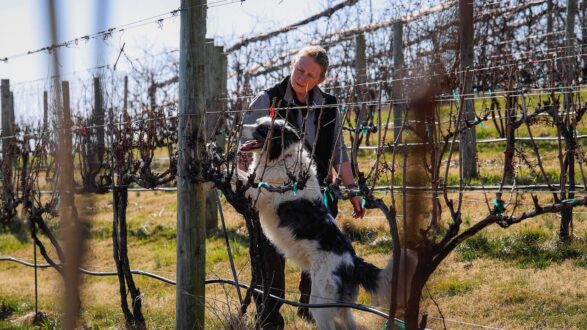Apr 12, 2023Dogs sniff out crop-killing spotted lanternflies
Researchers in Virginia Tech’s College of Agriculture and Life Sciences are enlisting dogs in the fight against the spread of the spotted lanternfly.
From New York to North Carolina and as far west as Illinois, the invasive spotted lanternfly is causing chaos in many states where agricultural and forestry industries are essential to the economy. Crop and forest production losses caused by insects and pathogens are close to $40 billion a year.
Spotted laternflies, native to mainland China, prey upon 70-plus host plant species, stealing their nutrients with their piercing snouts, called stylets. They are often characterized as “hitchhikers” for their ability to move long distances through human-assisted movement. Envision logging trucks traveling back and forth across the country with a few unwelcome pesky passengers braced to the back.


With a four-year, $475,000 grant from the U.S. Department of Agriculture-Agriculture and Food Research Initiative, Erica Feuerbacher, an associate professor of applied animal welfare and behavior in the School of Animal Sciences, and Mizuho Nita, a Virginia Cooperative Extension specialist and an associate professor in the School for Plant and Environmental Sciences, have partnered with researchers at Texas Tech University to combat the spotted lanternfly and the deadly fungal disease powdery mildew with the help of dogs and their citizen-scientist counterparts.
The project, unofficially called the Canine Citizen Science Study, began two years ago in an olfactory lab at Texas Tech and has recently expanded to the East Coast, where Feuerbacher and assistants are asking dog owners to use their pets’ scent work skills to sniff out spotted lanternfly eggs.
The nose knows
Flint is an 8-year-old border collie. He is energetic, playful, and very well-trained, thanks to the efforts of his talented owner and trainer, Sally Dickinson, a doctoral candidate in the School of Animal Sciences and a student of Feuerbacher’s.
Both women share an affinity for four-legged animals, especially dogs. Feuerbacher has a vested interest in dog welfare and behavior, while Dickinson has a strong background in training dogs for odor detection. Flint has been trained in emergency situations as a cadaver dog. More recently, he’s become an expert at finding spotted lanternfly eggs.
For decades, dogs and their impeccable noses, which possess up to 300 million olfactory receptors, have been used to detect missing people, narcotics and explosives. Nose work has also become an increasingly popular dog sport, Feuerbacher said.
“Every day, average dogs are competing and finding these scents, and that speaks to their potential ability to detect ecologically and agriculturally relevant targets,” Feuerbacher said.
On a recent afternoon, Flint showed off his impressive sense of smell at the Alson H. Smith Jr. Agricultural Research and Extension Center in Winchester, Virginia. The center is well-known for its contributions to the commercial fruit industry, including winegrape research. Dripping with clusters of sugary fruit, grapevines are especially prone to spotted lanternflies.
This was Flint’s first foray into the field. Up until this point, Dickinson had trained him at home using spotted lanternfly egg samples.
“To train a dog to detect an odor, we use a pairing mechanism,” Dickinson said. “The dog has to learn that a particular odor is of value to them. We present the odor and pair that with something that is pleasurable or edible — whatever is reinforcing to the dog. That creates a message in the dog’s mind that, ‘If I look for that thing, and I find it, something really good happens in my life.’”
For Flint, the reward was handfuls of treats as he worked his way through the grapevines, sniffing, stopping, and even pointing with his paw when lines of tiny eggs were detected.
Nita, who operates a grape disease management research and Extension lab at the research and Extension center, watched from afar with excitement.
He saw firsthand the detriment of the spotted lanternfly. He recalls flying a drone when the fly was first detected at the research center about two years ago.
“There were thousands,” he said.
As part of the canine detection project’s partnership with Texas Tech, Nita sends egg samples to the university’s Canine Olfaction Research and Education Laboratory. Under the leadership of Associate Professor Nathan Hall, the lab has conducted multiple behavioral and olfactory research studies. Nita and Hall have been at the forefront of the study for the past two years.
Early detection is critical to stopping and destroying the lanternfly, Nita said. Their eggs are very small and often laid on the underside of plants. As they develop into adults, the flies start feeding on the plants. What they don’t digest, they discharge on the leaves of the plant, inviting another issue: mold.
“Naturally, my fear is the risk to the quality of the grapes and the wines they produce,” Nita said. “I worry that growers will be overusing insecticides. While they have proved effective in killing the spotted lanternfly, they also cause harm to beneficial insects; therefore, it may bring other issues to our crops.”
Nita said he is hopeful that with early detection, the spotted lanternfly will be effectively managed, and slow down the rate of spread to the south, the path they are currently projected. And as the “dog detectives” master their craft, the research group will be challenging them to detect additional harmful predators, like the deadly plant pathogen, powdery mildew.
Stomp, squash, smash and sniff
Partnering with the National Association of Canine Scent Work, Feuerbacher and Dickinson will recruit teams of dogs and their owners to help detect spotted lanternfly eggs.
“This is a great opportunity for people to have fun with their dogs while also contributing back to their communities in a meaningful way,” Feuerbacher said.
Dickinson encourages dog owners to ignore the myths that certain dog breeds aren’t suitable for scent detection.
“There is plenty of research out there that indicates that all dogs can smell,” she said. “Maybe the ‘smooshy’-nosed dogs aren’t as good in the really hot weather to work for five hours straight, but they can definitely do it.”
Research has shown that scent training may also contribute to positive behavioral changes in dogs.
“At the completion of the study, we hope to have a strong network of handlers able to locate spotted lanternfly egg masses as a proof-of-concept program, with the intent to create an enduring citizen-based detection program for this and other invasive species,” Dickinson said. “Put your training skills to work and help protect our vineyards, fruit orchards and flower gardens.
— Mary Hardbarger, Virginia Tech
Top photo: Sally Dickinson and her trained detection dog, Flint, search the vineyard at the Alson H. Smith Jr. Agricultural Research and Extension Center in Winchester, Virginia, for spotted lantern fly egg masses. They are recruiting dogs and their owners to do the same through a four-year project funded by the U.S. Department of Agriculture. Photo: Luke Hayes for Virginia Tech.
















